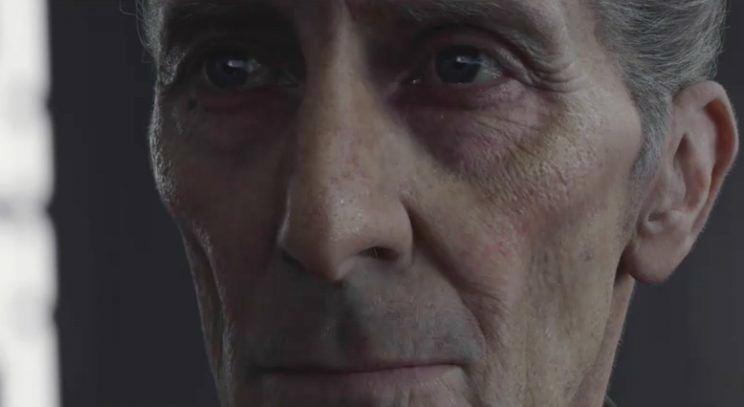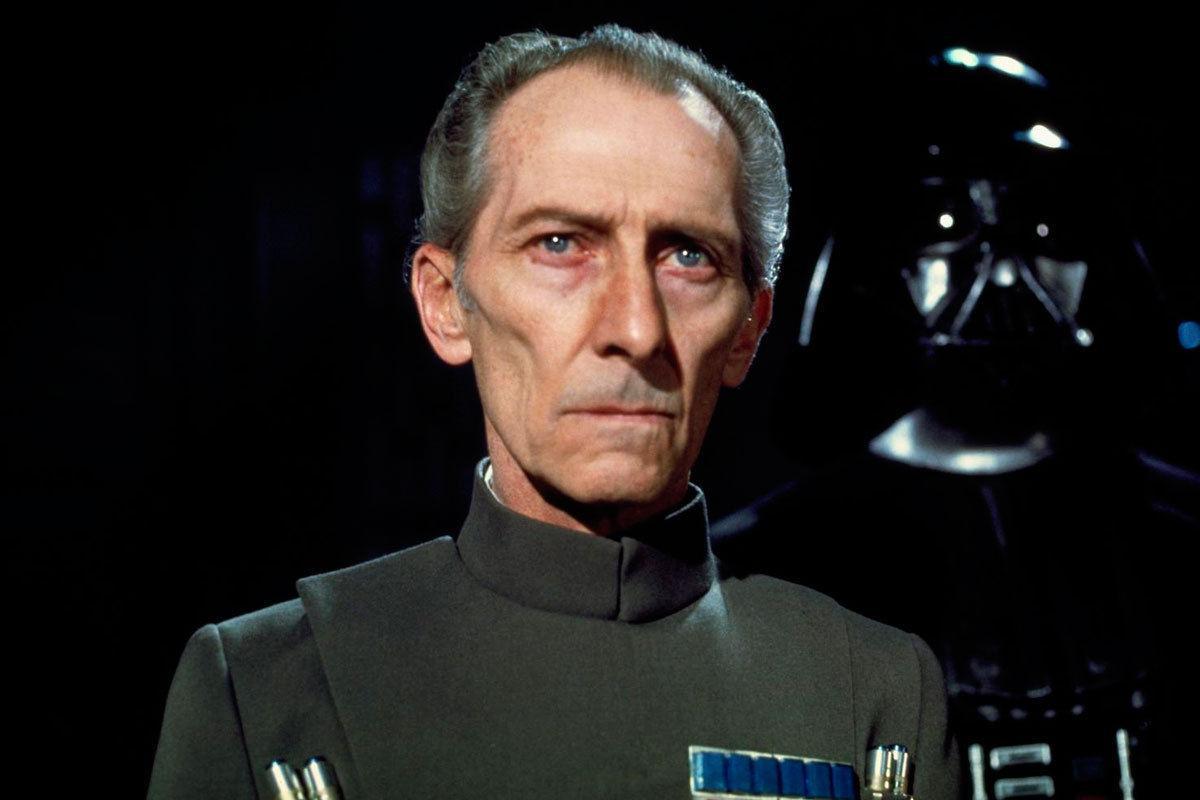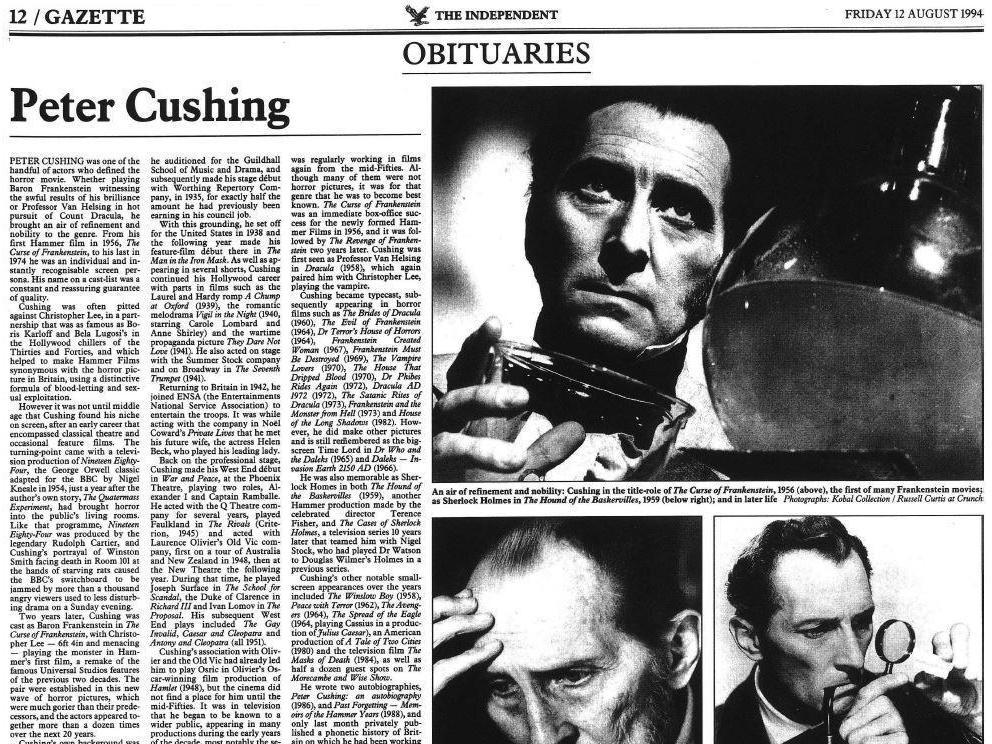A Life in Focus: Peter Cushing, the actor who personified the horror genre
The Independent revisits the life of a notable figure. This week: Peter Cushing, from Friday 12 August 1994

Peter Cushing was one of the handful of actors who defined the horror movie. Whether playing Baron Frankenstein witnessing the awful results of his brilliance or Professor Van Helsing in hot pursuit of Count Dracula, he brought an air of refinement and nobility to the genre. From his first Hammer film in 1956, The Curse of Frankenstein, to his last in 1974 he was an individual and instantly recognisable screen persona. His name on a cast-list was a constant and reassuring guarantee of quality.
Cushing was often pitted against Christopher Lee, in a partnership that was as famous as Boris Karloff and Bela Lugosi’s in the Hollywood chillers of the Thirties and Forties, and which helped to make Hammer Films synonymous with the horror picture in Britain, using a distinctive formula of blood-letting and sexual exploitation.
However it was not until middle age that Cushing found his niche on screen, after an early career that encompassed classical theatre and occasional feature films. The turning-point came with a television production of Nineteen Eighty-Four, the George Orwell classic adapted for the BBC by Nigel Kneale in 1954, just a year after the author’s own story, The Quatermass Experiment, had brought horror into the public’s living rooms. Like that programme, Nineteen Eighty-Four was produced by the legendary Rudolph Cartier, and Cushing’s portrayal of Winston Smith facing death in Room 101 at the hands of starving rats caused the BBC’s switchboard to be jammed by more than a thousand angry viewers used to less disturbing drama on a Sunday evening.
Two years later, Cushing was cast as Baron Frankenstein in The Curse of Frankenstein, with Christopher Lee – 6ft 4in and menacing – playing the monster in Hammer’s first film, a remake of the famous Universal Studios features of the previous two decades. The pair were established in this new wave of horror pictures, which were much gorier than their predecessors, and the actors appeared together more than a dozen times over the next 20 years.
Cushing’s own background was sedate by comparison with the situations in which he became embroiled on screen. Born in Kenley, Surrey, just before the First World War, he started his working life in the drawing office of the surveyor’s department at Coulsdon and Purley Urban District Council, earning 30 shillings a week. Determined to further his love of acting, he auditioned for the Guildhall School of Music and Drama, and subsequently made his stage debut with Worthing Repertory Company, in 1935, for exactly half the amount he had previously been earning in his council job.
With this grounding, he set off for the United States in 1938 and the following year made his feature-film debut there in The Man in the Iron Mask. As well as appearing in several shorts, Cushing continued his Hollywood career with parts in films such as the Laurel and Hardy romp A Chump at Oxford (1939), the romantic melodrama Vigil in the Night (1940, starring Carole Lombard and Anne Shirley) and the wartime propaganda picture They Dare Not Love (1941). He also acted on stage with the Summer Stock company and on Broadway in The Seventh Trumpet (1941).

Returning to Britain in 1942, he joined ENSA (the Entertainments National Service Association) to entertain the troops. It was while acting with the company in Noel Coward’s Private Lives that he met his future wife, the actress Helen Beck, who played his leading lady.
Back on the professional stage, Cushing made his West End debut in War and Peace, at the Phoenix Theatre, playing two roles, Alexander I and Captain Ramballe. He acted with the Q Theatre company for several years, played Faulkland in The Rivals (Criterion, 1945) and acted with Laurence Olivier’s Old Vic company, first on a tour of Australia and New Zealand in 1948, then at the New Theatre the following year.

During that time, he played Joseph Surface in The School for Scandal, the Duke of Clarence in Richard III and Ivan Lomov in The Proposal. His subsequent West End plays included The Gay Invalid, Caesar and Cleopatra and Antony and Cleopatra (all 1951).
Cushing’s association with Olivier and the Old Vic had already led him to play Osric in Olivier’s Oscar-winning film production of Hamlet (1948), but the cinema did not find a place for him until the mid-Fifties. It was in television that he began to be known to a wider public, appearing in many productions during the early years of the decade, most notably the serials Pride and Prejudice (1952) and Epitaph for a Spy (1953).
But it was the role of Winston Smith in that chilling television production of Nineteen Eighty-Four that made film directors see Cushing’s potential. While continuing to work on television, and winning a best television actor award three years running (1954-56), Cushing was regularly working in films again from the mid-Fifties. Although many of them were not horror pictures, it was for that genre that he was to become best known.
The Curse of Frankenstein was an immediate box-office success for the newly formed Hammer Films in 1956, and it was followed by The Revenge of Frankenstein two years later. Cushing was first seen as Professor Van Helsing in Dracula (1958), which again paired him with Lee, playing the vampire.
Cushing became typecast, subsequently appearing in horror films such as The Brides of Dracula (1960), The Evil of Frankenstein (1964), Dr Terror’s House of Horrors (1964), Frankenstein Created Woman (1967), Frankenstein Must Be Destroyed (1969), The Vampire Lovers (1970), The House That Dripped Blood (1970), Dr Phibes Rides Again (1972), Dracula AD 1972 (1972), The Satanic Rites of Dracula (1973), Frankenstein and the Monster from Hell (1973) and House of the Long Shadows (1982). However, he did make other pictures and is still remembered as the big-screen Time Lord in Dr Who and the Daleks (1965) and Daleks – Invasion Earth 2150 AD (1966).
He was also memorable as Sherlock Homes in both The Hound of the Baskervilles (1959), another Hammer production made by the celebrated director Terence Fisher, and The Cases of Sherlock Holmes, a television series 10 years later that teamed him with Nigel Stock, who had played Dr Watson to Douglas Wilmer’s Holmes in a previous series.
Cushing’s other notable small-screen appearances over the years included The Winslow Boy (1958), Peace with Terror (1962), The Avengers (1964), The Spread of the Eagle (1964, playing Cassius in a production of Julius Caesar), an American production of A Tale of Two Cities (1980) and the television film The Masks of Death (1984), as well as half a dozen guest spots on The Morecambe and Wise Show.
He wrote two autobiographies, Peter Cushing: an autobiography (1986), and Past Forgetting – Memoirs of the Hammer Years (1988), and only last month privately published a phonetic history of Britain on which he had been working for many years, The Bois Saga, featuring such characters as “Ladee Go-Diver” and “Jooleeus Seesaw”.
Peter Wilton Cushing, actor: born Kenley, Surrey 26 May 1913; OBE 1989; married 1943 Helen Beck (died 1971); died Canterbury 11 August 1994
Join our commenting forum
Join thought-provoking conversations, follow other Independent readers and see their replies
Comments